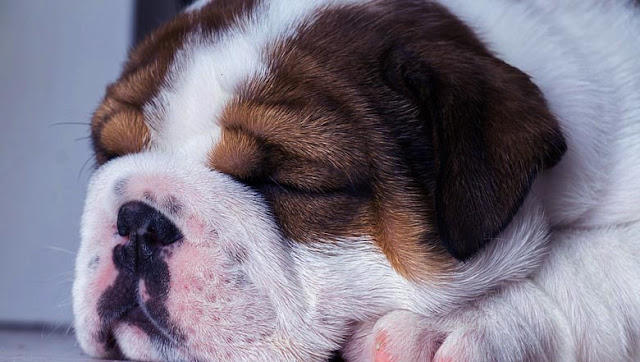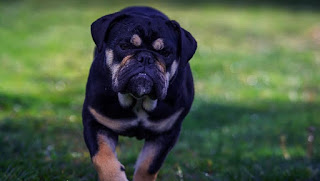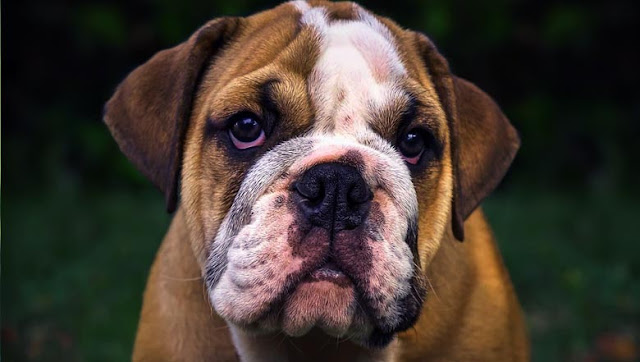He always looks angry, doesn't hesitate to get comfortable and snores... You think that the English Bulldog is really not the ideal part...
He always looks angry, doesn't hesitate to get comfortable and snores... You think that the English Bulldog is really not the ideal partner? You're wrong! The unique charm of the English Bulldog, his sense of humor, his friendliness and his slightly clumsy side will make you melt!

English Bulldog Article Contents
- Character of the English bulldog
- History and breeding of the English bulldog
- Appearance of the English Bulldog
- Health and care of the English Bulldog
- English Bulldog Education
Character of the English bulldog
The appearance of this breed of dog can be deceptive, as it does not reflect the character of the English Bulldog. Behind its coarse appearance and grumpy look is a friendly dog. When he is with his master, the English Bulldog is even very affectionate and sometimes sensitive. When his master raises his voice, he reacts immediately, sometimes stubbornly. Even though English Bulldogs are very affectionate dogs and very close to their master, they remain obstinate. They are even capable of ignoring overly strict orders or orders in which they see no interest.
This is how the Bulldog Club explains that these dogs can be trained, provided that it is taken into account that they have absolutely no obedience. However, if one conquers the Bulldog's heart, if one offers him a consistent and loving education, he will prove to be docile and easy to live with. Due to its calm nature, the English Bulldog is nowadays a much appreciated companion dog, which can be taken everywhere, whether for a dinner in a restaurant or an overnight stay in a hotel.
Bulldogs love children and are therefore very suitable dogs for families. During playtime, this imposing dog may underestimate its strength. Therefore, do not let it play unsupervised with small children.
Unlike the Dalmatian or Border Collie, English Bulldogs almost never stomp in front of their master and do not show any particular desire to go for a walk. You therefore need motivation and persuasion to get them out of their comfortable dog baskets and baskets.
Once they get over their slackness, English Bulldogs are so enthusiastic about dog games that they don't want to stop. The great animal painter and cytologist Richard Strebel, himself a breeder of the English Bulldog breed, described the characteristics of his bulldogs more than 100 years ago: "The main characteristic of the Bulldog is his kindness. He has a certain phlegm, until something awakens his sleeping passion. There is an obvious contradiction and no one can deny the fact that phlegm and passion are incompatible. When his passion awakens, one notices then a great perseverance and a strong will in these dogs. »
It is precisely this contradiction that makes the character of the English bulldog so irresistible. He is furious and determined in his expression, but docile and reliable in his behavior. Phlegmatic, always at ease, this little grouch suddenly becomes active and passionate when something catches his attention.
History and breeding of the English bulldog
When you look at its history, you quickly understand where the famous contradiction in the character of the English bulldog comes from. No other breed has undergone as much evolution as the English Bulldog. In short, once bred as an aggressive and courageous "fighting machine", it has since become a sensitive and affectionate companion dog that runs away from violence.
Back to the beginning :
- This breed was already present in the 6th century B.C. when the Phoenicians brought their dogs to the British Isles for commercial purposes. This is how they crossed them with the great local dogs.
- In the 13th century, these brave dogs were called " Bonddog " or " Bolddog ". They were used to participate in bull fights. Impressive by their daring character and strength, these dogs soon became " Bull biters ", or " Bullenbeisser ". In the Middle Ages, bull fights made the reputation of these dogs, hence the name "Bulldog".
- Between the 16th and 18th centuries, the "Bull Baiting", or "bull fighting", was a popular event in Great Britain, where people often bet large sums of money. Soon bull fights developed and fighting dogs were brought to fight larger and larger animals such as bears, monkeys and even lions.
At that time, Bulldogs were only used as fighting dogs and had to appear as aggressive as possible. While the character of the bulldog at that time was mainly marked by courage and aggressiveness, a certain importance was attached to his physique. These mimosoid dogs had to have a broad jaw and nose to facilitate their breathing when they were attacking bulls. When in 1835 in Great Britain, the government banned these fighting dogs, the Bulldogs were removed from the farms. As time went by, these fearsome dogs disappeared.
In the past, behind their fighting dog look, nobody could guess the cuddly character of these hairballs! In the middle of the 19th century, the breeding of a new type of Bulldog was born. He was then characterized by his gentleness and no longer by his aggressiveness. In 1864, the newly created " Bulldog Club " established the breed standard. In 1875, the creation of the Bulldog Club Incorporated marked the beginning of English Bulldog breeding. Breeders of former fighting dogs introduced friendly and tolerant companion dogs, which soon met with great success. This new Bulldog with its striking appearance became the companion dog of British gentlemen and finally a typical dog breed in Great Britain.
Unfortunately, these animals were intensively bred and the standardization of the breed reached extreme requirements: very large wrinkled heads, wide muzzles and too short limbs led in some cases to breeding that made the animals suffer. In addition to breathing and fertility problems, the oversized size of the English Bulldog's head and narrow hips mostly prevented females from giving birth naturally. Caesarean section rates increased by more than 80%. In order to put an end to this extreme breeding, the British Kennel Club defined a new standard in 2009 despite massive protests from English Bulldog breeders. Since then, the health and well-being of dogs has been at the heart of English Bulldog breeding. Since October 2010, the FCI has taken over the responsibility of maintaining the English Bulldog standard.
Appearance of the English Bulldog
The Bulldog is still characterized today by a broad head and chest, a rather narrow hindquarters and very short legs. However, these characteristics should not be taken to extremes, otherwise the dog's ability to move will be impaired. Their compact and stocky body must be well proportioned. Even if males weighing about 25 kg are heavy enough for their small size, their gait should not appear clumsy.
A healthy English Bulldog is active and has no tendency to be overweight. Dogs with clearly visible respiratory problems are not desired according to the standard. The small, thin English Bulldog ears, sometimes referred to as "pink ears", are widely spaced. The tail is curved downwards, however, the corkscrew tail is forbidden by the standard. The short and very fine coat of the English Bulldog can be of different colors.
The following coat colors can be noted in particular:
- White
- Red
- Ochre
- Fauve
- Brindle
- Mottled.
The black color is not recognized by the English bulldog breed standard.
Health and care of the English Bulldog
The short, shiny coat of the Bulldog is very easy to maintain. All you need to do is bring dog towels with you to clean the dog's coat. The eyes and nose need daily cleaning and care to avoid infectious diseases.
Furthermore, the English Bulldog is a relatively fragile dog. Long walks should be avoided during heat waves. In hot weather, your dog should be able to drink enough water and rest in shady places. Throughout the year, one to two daily walks are necessary. Even if Bulldogs seem lazy, it is essential for them to exercise a minimum and to have a healthy and balanced diet, meeting the specific needs of the Bulldog breed. These precautions help prevent weight gain and even obesity in the English Bulldog, which is not uncommon in this breed!
In addition, many Bulldogs suffer from respiratory problems: they have difficulty breathing and snore. Other typical illnesses in the English Bulldog are :
- Hip problems
- Allergies
- Epilepsy
- Cherry Eyes", a disease of the nictitating gland, causing inflammation.
Would you like to adopt an English bulldog as your faithful companion? Ask the breeder about possible diseases of the breed and make sure that the 2009 standard is taken into account.
English Bulldog Education
The English Bulldog is a very pleasant companion dog, who feels at ease both alone with his master and in a large family. Having a Bulldog as a companion guide in the family will be a huge chance for your little protégé. However, cohabitation with cats is problematic. For the English Bulldog, the love of his owners is the only thing that counts. Whether he lives in a flat with his owner or in a large house, surrounded by a family, an English Bulldog will always like to be the center of attention. He is a calm and balanced partner who is not made for the noise and bustle of the big cities.
If you are sporty and like to move around, you will find it difficult to convince your pet to go for long walks, dog sports or outdoor games. Of course, their respiratory problems have to be taken into account, but the main reason for this lack of motivation is that they see no point in jumping over obstacles when they can just pass by...
The obstinate character of Bulldogs is likely to resurface! Bulldog masters must be able to assert themselves with determination in order to lead these "moleheads" to the right path. For a fulfilling relationship with an English Bulldog, a good sense of humor and a conciliatory character are advisable. Indeed, do not expect absolute obedience from these dogs. If trained with a lot of love and patience (not to mention rewards) then the Bulldog will prove to be a loyal and affectionate companion.
- We wish you a wonderful time with your English companion!



No comments